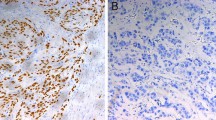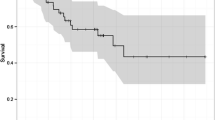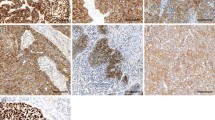Abstract
Background: We investigated whether aberrant p53 and p16 expression, the Ki-67 labeling index (LI), and int-2/cyclin D1 gene amplification predict the response to chemoradiotherapy (CRT) in patients with locally advanced esophageal squamous cell carcinoma (ESCC).
Methods: p53 and p16 expression status, the Ki-67 LI, and int-2/cyclin D1 amplification were assessed by immunohistochemical staining and slot blot analysis in pretreatment endoscopic biopsy specimens of 41 patients with T4 or M1 Lym (distant lymph node metastasis) ESCC. All patients received a course of chemotherapy (5-fluorouracil and cisplatin) with radiotherapy.
Results: The CRT therapeutic response rate was 71%, and resection after CRT was successful in 15 of the cases in which the CRT effect was significant. The cumulative survival rate after CRT in the p53-negative patients was significantly higher than in the p53-positive patients (P = .037). The mean Ki-67 LI in the CRT response cases was significantly higher than in the CRT no-response cases (P = .023). Multivariate regression analysis revealed high Ki-67 LI to be an independent variable linked to a pathologic complete response to CRT (P = .033). The cumulative survival rate after CRT in the group that was p53-negative and int-2/cyclin D1 amplification-positive was significantly higher than in the other groups (P = .008).
Conclusions: Evaluating predictive factors in pretreatment endoscopic biopsy specimens may allow selection of more suitable multimodal treatment for ESCC patients and improve their quality of life.
Similar content being viewed by others
REFERENCES
Iizuka T, Isono K, Kakegawa T, Watanabe H. Parameter linked to ten-year survival in Japan of resected esophageal carcinoma. Chest 1989; 96: 1005–11.
Ohtsu A, Boku N, Muro K, et al. Definitive chemoradiotherapy for T4 and/or M1 lymph node squamous cell carcinoma of the esophagus. J Clin Oncol 1999; 17: 2915–21.
Ide H, Nakamura T, Hayashi K, et al. Esophageal squamous cell carcinoma: pathology and prognosis. World J Surg 1994; 18: 321–30.
Ando N, Ozawa S, Kitagawa Y, Shinozawa Y, Kitajima M. Improvement in the results of surgical treatment of advanced squamous esophageal carcinoma during 15 consecutive years. Ann Surg 2000; 232: 225–32.
Shinozaki H, Ozawa S, Ando N, et al. Cyclin D1 amplification as a new predictive classification for squamous cell carcinoma of the esophagus, adding gene information. Clin Cancer Res 1996; 2: 1155–61.
Takeuchi H, Ozawa S, Ando N, et al. Altered p16/MTS1/CDKN2 and cyclin D1/PRAD-1 gene expression is associated with the prognosis of squamous cell carcinoma of the esophagus. Clin Cancer Res 1997; 3: 2229–36.
Matsushime H, Roussel MF, Ashumun RA, Sherr CJ. Colony-stimulating factor 1 regulates novel cyclins during the G1 phase of the cell cycle. Cell 1991; 65: 701–13.
Motokura T, Bloom T, Kim HG, et al. A novel cyclin encoded by a bcl1-linked candidate oncogene. Nature (Lond) 1991; 350: 512–5.
Kitagawa Y, Ueda M, Ando N, Shinozawa Y, Shimizu N, Abe O. Significance of int-2/hst-1 coamplification as a prognostic factors in patients with esophageal squamous cell carcinoma. Cancer Res 1991; 51: 1504–8.
Wagata T, Shibagaki I, Imamura M, et al. Loss of 17p, mutation of the p53 gene, and overexpression of p53 protein in esophageal squamous cell carcinomas. Cancer Res 1993; 53: 846–50.
Gao H, Wang LD, Zhou Q, Hong JY, Huang TY, Yang CS. p53 tumor suppressor gene mutation in early esophageal precancerous lesions and carcinoma among high-risk populations in Henan, China. Cancer Res 1994; 54: 4342–6.
Shimaya K, Shiozaki H, Inoue M, et al. Significance of p53 expression as a prognostic factor in esophageal squamous cell carcinoma. Virchows Arch A Pathol Anat Histopathol 1993; 422: 271–6.
Sarbia M, Porschen R, Borchard F, Horstmann O, Willers R, Gabbert HE. p53 protein expression and prognosis in squamous cell carcinoma of the esophagus. Cancer 1994; 74: 2218–23.
Sturm I, Petrowsky H, Volz R, et al. Analysis of p53/BAX/p16ink4a/CDKN2 in esophageal squamous cell carcinoma: high BAX and p16ink4a/CDKN2 identifies patients with good prognosis. J Clin Oncol 2001; 19: 2272–81.
Spitz FR, Giacco GG, Hess K, et al. p53 immunohistochemical staining predicts residual disease after chemoradiotherapy in patients with high-risk rectal cancer. Clin Cancer Res 1997; 3: 1685–90.
Bergh J, Norberg T, Sjogren S, Lindgren A, Holmberg L. Complete sequencing of the p53 gene provides prognostic information in breast-cancer patients, particularly in relation to adjuvant systemic therapy and radiotherapy. Nat Med 1995; 1: 1029–34.
Youssef EM, Matsuda T, Takada N, et al. Prognostic significance of the MIB-1 proliferative index for patients with squamous cell carcinoma of the esophagus. Cancer 1995; 76: 358–66.
Lam KY, Law SYK, So MKP, Fok M, Ma LT, Wong J. Prognostic implication of proliferative markers MIB-1 and PC10 in esophageal squamous cell carcinoma. Cancer 1996; 77: 7–13.
Deisseroth AB, DeVita VT Jr. The cell cycle. Probing new molecular determinants of resistance and sensitivity to cytotoxic agents. Cancer J 1995; 1: 15–21.
Japanese Society for Esophageal Diseases. Guidelines for the Clinical and Pathologic Studies on Carcinoma of the Esophagus. 9th ed. Tokyo: Kanehara Public Co, 1999.
van den Berg FM, Baas IO, Polak MM, Offerhaus GJA. Detection of p53 overexpression in routinely paraffin-embedded tissue of human carcinomas using a novel target unmasking fluid. Am J Pathol 1993; 142: 381–5.
Casey G, Lopez ME, Ramos JC, et al. DNA sequence analysis of exon 2 through 11 and immunohistochemical staining are required to detect all known p53 alternations in human malignancies. Oncogene 1996; 13: 1971–81.
Sgambato A, Migaldi M, Leocata P, et al. Loss of p27kip1 expression is a strong independent prognostic factor of reduced survival in N0 gastric carcinomas. Cancer 2000; 89: 2247–57.
Takeuchi H, Ozawa S, Ando N, et al. Further evidence that altered p16/CDKN2 gene expression is associated with lymph node metastasis in squamous cell carcinoma of the esophagus. Oncol Rep 2001; 8: 627–32.
Ikeda Y, Ozawa S, Ando N, Kitagawa Y, Ueda M, Kitajima M. Meanings of c-erb B and int-2 amplification in superficial esophageal squamous cell carcinomas. Ann Thorac Surg 1996; 62: 835–8.
Levine AJ, Momand J, Finlay CA. The p53 tumor suppressor gene. Nature 1991; 351: 453–6.
Finlay CA, Hinds PW, Tan TH, Eliyahu D, Oren M, Levine AJ. Activating mutations for transformation by p53 produce a gene product that forms an hsc70-p53 complex with an altered half life. Mol Cell Biol 1988; 8: 531–9.
Scott N, Sagar P, Stewart J, Blair GE, Dixon MF, Quirke P. p53 in colorectal cancer: clinicopathological correlation and prognostic significance. Br J Cancer 1991; 63: 317–9.
Lowe SW, Ruley HE, Jacks T, Housman DE. p53-dependent apoptosis modulates the cytotoxicity of anticancer agents. Cell 1993; 74: 957–67.
McIlwrath AJ, Vasey PA, Ross GM, Brown R. Cell cycle arrests and radiosensitivity of human tumor cell lines: dependent on wild-type p53 for radiosensitivity. Cancer Res 1994; 54: 3718–72.
Fujiwara T, Grimm EA, Mukhopadhyay T, Zhang WW, Owen-Schaub LB, Roth JA. Induction of chemosensitivity in human lung cancer cells in vivo by adenovirus-mediated transfer of the wild-type p53 gene. Cancer Res 1994; 54: 2287–91.
Maesawa C, Tamura G, Nishizuka S, et al. Inactivation of the CDKN2 gene by homozygous deletion and de novo methylation is associated with advanced stage esophageal squamous cell carcinoma. Cancer Res 1996; 56: 3875–8.
Mendonca MS, Rodriguez A, Alpen EL. Quiescence in pL cells and correlation with radiosensitivity and PLD repair. Radiat Res 1989; 117: 433–47.
Masunaga S, Ono K, Abe M. A method for the selective measurement of the radiosensitivity of quiescent cells in solid tumors—combination of immunofluorescence staining to BrdU and micronucleus assay. Radiat Res 1991; 125: 243–7.
Nakano T, Oka K. Differentiation values of Ki-67 index and mitotic index of proliferating cell population, an assessment of cell cycle and prognosis in radiation therapy for cervical cancer. Cancer 1993; 72: 2401–8.
Okuno Y, Nishimura Y, Kashu I, Ono K, Hiraoka M. Prognostic values of proliferating cell nuclear antigen (PCNA) and Ki-67 for radiotherapy of oesophageal squamous cell carcinomas. Br J Cancer 1999; 80: 387–95.
Warenius HM, Seabra LA, Maw P. Sensitivity to cis-diamminedichloroplatinum in human cancer cells is related to expression of cyclin D1 but not c-raf-1 protein. Int J Cancer 1996; 67: 224–31.
Hochhauser D, Schnieders B, Ercikan-Abali E, et al. Effect of cyclin D1 overexpression on drug sensitivity in a human fibrosarcoma cell line. J Natl Cancer Inst 1996; 88: 1269–75.
Martin JMC, Balkenende A, Verschoor T, Lallemand F, Michalides R. Cyclin D1 overexpression enhances radiation-induced apoptosis and radiosensitivity in a breast tumor cell line. Cancer Res 1999; 59: 1134–40.
Kranenburg O, van der Eb AJ, Zantema A. Cyclin D1 is an essential mediator of apoptotic neuronal cell death. EMBO J 1996; 15: 46–54.
Sofer-Levi Y, Resnitzky D. Apoptosis induced by ectopic expression of cyclin D1 but not cyclin E. Oncogene 1996; 13: 2431–7.
Shamma A, Doki Y, Shiozaki H, et al. Effect of cyclin D1 and associated proteins on proliferation of esophageal squamous cell carcinoma. Int J Oncol 1998; 13: 455–60.
Musgrove EA, Lee CS, Buckley MF, Sutherland RL. Cyclin D1 induction in breast cancer cell lines shortens G1 and is sufficient for cells arrested in G1 to complete the cell cycle. Proc Natl Acad Sci U S A 1994; 91: 8022–6.
Konishi T, Hiraishi M, Mafune K, et al. The therapeutic efficacy and toxicity of sequential methotrexate and 5-fluorouracil in gastric cancer. Anticancer Res 1994; 14: 1277–9.
Shintani S, Mihara M, Ueyama Y, Matsumura T, Wong DTW. Cyclin D1 overexpression associates with radiosensitivity in oral squamous cell carcinoma. Int J Cancer 2001; 96: 159–65.
Yoo SS, Carter D, Turner BC, et al. Prognostic significance of cyclin D1 protein levels in early-stage larynx cancer treated with primary radiation. Int J Cancer 2000; 90: 22–8.
Akervall J, Brun E, Dictor M, Wennerberg J. Cyclin D1 overexpression versus response to induction chemotherapy in squamous cell carcinoma of the head and neck—preliminary report. Acta Oncol 2001; 40: 505–11.
Hwang CF, Cho CL, Huang CC, et al. Loss of cyclin D1 and p16 expression correlates with local recurrence in nasopharyngeal carcinoma following radiotherapy. Ann Oncol 2002; 13: 1246–51.
Ajani JA. Preoperative therapy for patients with resectable squamous cell carcinoma of the esophagus: are we still confused? Ann Surg Oncol 2002; 9: 605–6.
Chan ACW, Lee DWH, Griffith JF, et al. The clinical efficacy of neoadjuvant chemotherapy in squamous esophageal cancer: a prospective nonrandomized study of pulse and continuous-infusion regimens with cisplatin and 5-fluorouracil. Ann Surg Oncol 2002; 9: 617–24.
Geh JI, Crellin AM, Glynne-Jones R. Preoperative (neoadjuvant) chemoradiotherapy in oesophageal cancer. Br J Surg 2001; 88: 338–56.
Jones DR, Detterbeck FC, Egan TM, Parker LA Jr, Bernard SA, Tepper JE. Induction chemoradiotherapy followed by esophagectomy in patients with carcinoma of the esophagus. Ann Thorac Surg 1997; 64: 185–92.
Ancona E, Ruol A, Santi S, et al. Only pathologic complete response to neoadjuvant chemotherapy improves significantly the long term survival of patients with resectable esophageal squamous cell carcinoma: final report of a randomized, controlled trial of preoperative chemotherapy versus surgery alone. Cancer 2001; 91: 2165–74.
Lew JI, Gooding WE, Ribeiro U Jr, Safatle-Ribeiro AV, Posner MC. Long-term survival following induction chemoradiotherapy and esophagectomy for esophageal carcinoma. Arch Surg 2001; 136: 737–42.
Heath EI, Burtness BA, Heitmiller RF, et al. Phase II evaluation of preoperative chemoradiation and postoperative adjuvant chemotherapy for squamous cell and adenocarcinoma of the esophagus. J Clin Oncol 2000; 18: 868–76.
Slater MS, Holland J, Faigel DO, Sheppard BC, Deveney CW. Does neoadjuvant chemoradiation downstage esophageal carcinoma? Am J Surg 2001; 181: 440–4.
Ikeda K, Ishida K, Sato N, et al. Chemoradiotherapy followed by surgery for thoracic esophageal cancer potentially or actually involving adjacent organs. Dis Esophagus 2001; 14: 197–201.
Author information
Authors and Affiliations
Corresponding author
Rights and permissions
About this article
Cite this article
Takeuchi, H., Ozawa, S., Ando, N. et al. Cell-Cycle Regulators and the Ki-67 Labeling Index Can Predict the Response to Chemoradiotherapy and the Survival of Patients With Locally Advanced Squamous Cell Carcinoma of the Esophagus. Ann Surg Oncol 10, 792–800 (2003). https://doi.org/10.1245/ASO.2003.10.014
Received:
Accepted:
Issue Date:
DOI: https://doi.org/10.1245/ASO.2003.10.014




